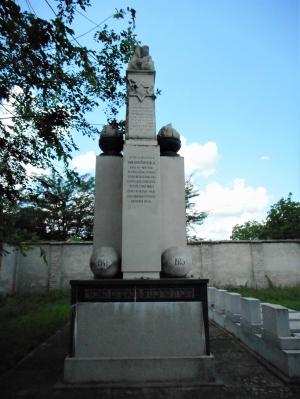Obj. ID: 44762
Jewish Funerary Art Holocaust Memorial Complex in the Jewish cemetery in Subotica, Serbia, 1948
To the main object: Jewish cemetery in Subotica, Serbia

Memorial Name
No official name
Who is Comemmorated?
Victims of the Holocaust from Subotica
Description
This memorial is part of a complex consisting of this monument, ten individual graves, and one common grave of the Bor mine forced labor camp victims. It is made of artificial stone, marble from the island of Brač, and black granite.
The monument is a stele with obelisk-like proportions standing on a high platform. Its base is surrounded by four cubes forming the shape of a Greek cross. The memorial features the Magen David, Ner Tamid, and Torah Scroll Jewish motifs. There are commemorative inscriptions on all four sides of the memorial. Between the cubes lying on the platform are four stone balls that are engraved with the years 1941 and 1945. On the front side are dedications in Serbo-Croatian (on the lower part) and Hebrew (on the upper section of the monument) between which is a Magen David. On the rear side is an inscription in Serbo-Croatian.
Inscriptions
Front
Hebrew
מי שמבקש עלבונה של
ספר תורה הוא יבקש
עלבון הנפשות של
ארבעת אלפים בערך
המובלות בעריצות
פאשיסטית מעיר סובוטיצה
ומקודשות כעולם כליל
על מזבח דתם ולאומיותם
Translation: He who will have regard for the plight of the Torah will also have regard for the plight of some 4000 souls deported in fascist tyranny from the city of Subotica, martyrs who fell as a burnt offering on the altar of their religion and faith.
Serbo-Croatian
Večita slava i hvala
4000 subotičkih Jevreja
koji su odvučeni
po fašističkoj nemani u
njenom besnilu i paklenoj
grozoti a radi istrebljenja
- položili svoje drage
živote na oltaru svoje
vere i narodnosti te opšte
napredne misli.
Translation: Eternal glory and gratitude to 4,000 Jews from Subotica who were dragged by the fascist beast in its fury and hellish horror and for the purpose of extermination - laid their dear lives on the altar of their faith and nationality and generally progressive thinking.
On the rear side (Serbo-Croatian)
Čoveče! Kad god ti oko
za ovaj spomenik zapne
nek se u tebi plamen
gneva razbukne,
napuni se jezom prema
svakome čoveku-nakazi
koji se kao fašista
čovek-om usudi nazivat.
Translation: Man! Whenever your eye falls on this monument, the flame of anger should blaze in you, fill yourself with anger toward every man-monster, who dared as a fascist to call himself a man.
Mauthausen
Strasshof
Bácsalmás
Budapest
Stutthof
Context: Places where Subotica Jews were killed
Left Face (from Front)
Sátoraljaújhely
Istočni front,
Bor-Cservenka,
Gunskirchen,
Hidegség
Context: Places where Subotica Jews were killed
Right Face (from Front)
Theresienstadt
Bergen-Belsen
Buchenwald
Auschwitz
Dachau
Context: Places where Subotica Jews were killed
On the stone balls, facing all four directions
1941- -1945
On the bases of all four sides
Serbo-Croatian
za uspomenu žrtvama svirepog fašizma
za živote vaše sloboda naša
Hebrew
לזכרון קרבנות הפאשיזם האכזרי;
חלף חייכם חרות שלנו
Translation: For the memory of the victims of cruel fascism / For your lives our freedom.
Commissioned by
The Jewish Community of Subotica
sub-set tree:
Marble
Granite (black)
Jews began settling in Subotica in the second half of the 18th century. At that time, the Hevra Kadisha was established. The cemetery was founded in 1795. The first synagogue was built in 1817, on Šumska Street, and it was rebuilt in 1850. The community was divided into two streams. The majority of members joined the Neolog stream, while the minority established an Orthodox community. The grandiose Neolog synagogue on 6 Jakab and Komor Square was built in 1902.
In 1915, the Orthodox community bought the Hevra Kadisha building on 15 Frankopanska Street, which was expanded and used as a synagogue. Both buildings exist today. There is no memorial plaque on the building of the orthodox synagogue.
Until the Second World War, the Jewish community of Subotica was the fourth largest in Yugoslavia. In the 1930s it numbered about 6,500 members. The number of Holocaust survivors is 1048. The Jewish Community of Subotica is active today.
The monument to the victims at the Jewish cemetery in Subotica was unveiled on September 5, 1948. Between 1947 and 1948, there were several similar "ad hoc, uncoordinated initiatives that were driven largely by the sense of obligation of the surviving Jews towards their murdered relatives and friends." [Kerenji, p. 209] As a result of these initiatives small monuments and plaques were dedicated by communities in Vojvodina, among them Subotica, Sombor, Stara Kanjiža and Senta.
Commemoration ceremonies are held every year marking the anniversary of the deportation of the Subotica Jews on 16 June 1944
Duranci, Bela and Vera Gabrić Počuča, Javni spomenici opštine Subotica, (Subotica: Međuopštinski zavod za zaštitu spomenika kulture, 2001)
Kerenji, Emil, “Jewish Citizens of Socialist Yugoslavia: Politics of Jewish Identity in a Socialist State, 1944–1974,” Ph.D. diss., University of Michigan, 2008, p. 201., https://deepblue.lib.umich.edu/bitstream/handle/2027.42/60848/ekerenji_1.pdf?sequence=1. June 2020 (accessed February 23, 2022)
"Memorials in Subotica,” Locations (Vojvodina Holocaust Memorials Project), https://www.vhmproject.org/en-US/Locations/Memorials/22 (accessed June 28, 2023)
"Obeležena 73. godišnjica deportacije subotičkih Jevreja," Subotica.info, https://www.subotica.info/2017/06/16/obelezena-73-godisnjica-deportacije-subotickih-jevreja (accessed June 28, 2023)
Stipić, Davor, ''U borbi protiv zaborava: Jevrejska zajednica u Jugoslaviji i očuvanje sećanja na Holokaust 1945-1955,'' Godišnjak za društvenu istoriju 2 (2016), pp. 91-121.
Ungar, Olga, "Remembering the Victims: Vojvodina Holocaust Memorials," in Jewish Literatures and Cultures in Southeastern Europe: Experiences, Positions, Memories (=Schriften des Centrums für jüdische Studien, vol. 37) eds Renate Hansen-Kokoruš and Olaf Terpitz, pp. 217-236.
“Jevrejsko groblje Subotica” Jevrejska opština Subotica, http://groblje.josu.rs/pretrazi-groblje/ (accessed June 28, 2023)






















